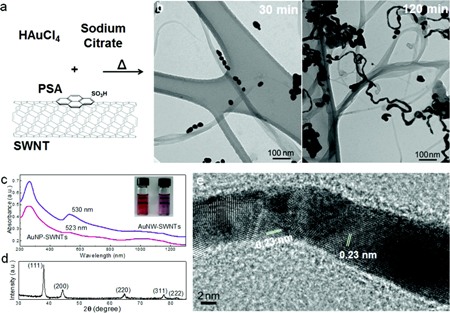A research team led by Alexander Star from the University of Pittsburgh together with researchers from the National Energy Technology Laboratory has developed a self-assembly technique using scaffolds for growing gold nanowires.
 Synthesis and characterization of gold nanowires
Synthesis and characterization of gold nanowires
These nanowires can be used as a cost-effective material for sensing poisonous gases present in natural gas. The study results titled ‘Welding of Gold Nanoparticles on Graphitic Templates for Chemical Sensing’ were reported online in the Journal of the American Chemical Society.
Star’s research team discovered that gold nanomaterials are capable of detecting hydrogen sulfide thanks to the high affinity of gold towards sulfur and novel physical properties of nanomaterials. The team studied the self-assembly process on graphene and carbon nanotubes using transmission electron microscopy, X-ray diffraction and computer modeling. It also studied the responses of the resulting materials to hydrogen sulfide.
Star explained that the team produced the gold nanowires by suspending nanotubes in water along with chloroauric acid containing gold. The subsequent stirring and heating of the mixture reduced the gold to form nanoparticles on the exterior walls of the nanotubes, resulting in the formation of a highly conductive mixture of carbon nanotubes and gold nanowires.
In order to evaluate the capability of the nanowires to sense hydrogen sulfide, the research team used the composite material to form a film onto a gold electrode-patterned chip. The team was able to detect hydrogen sulfide gas at a level down to 5 ppb, a value equivalent to that of current sensing techniques. Moreover, it was able to sense the presence of the gas in complex mix of gases imitating natural gas. Star stated that the team will now evaluate the detection limits of the chip utilizing real samples from gas wells.